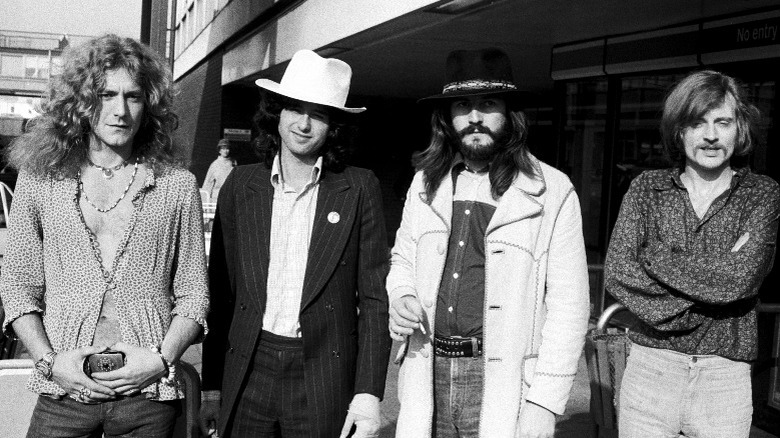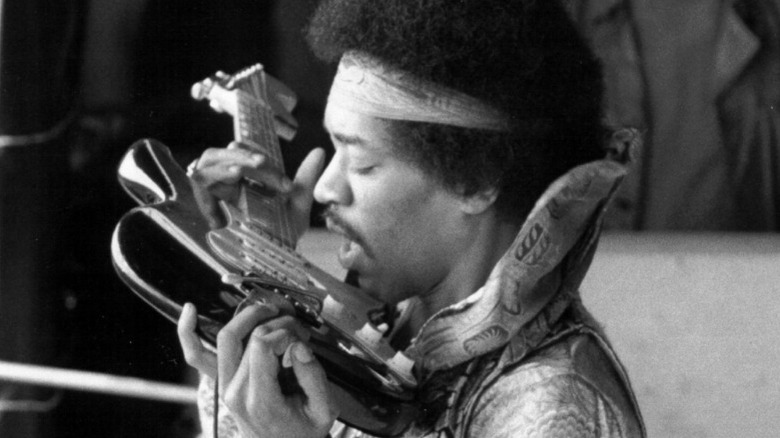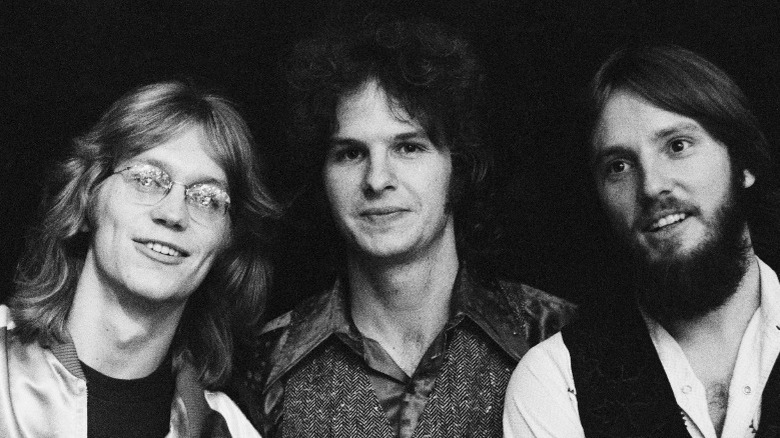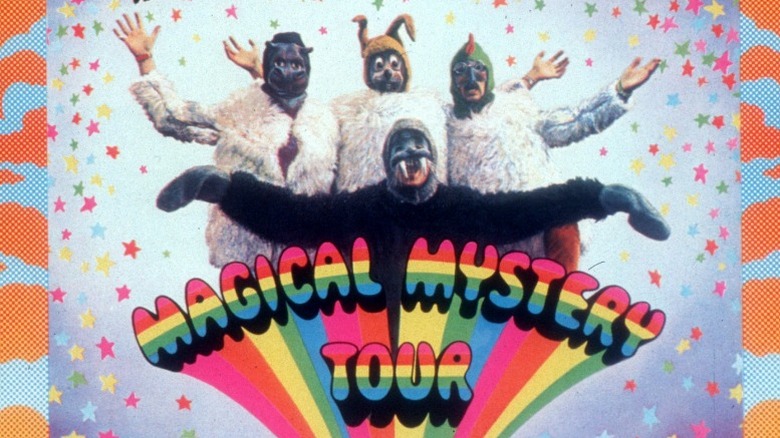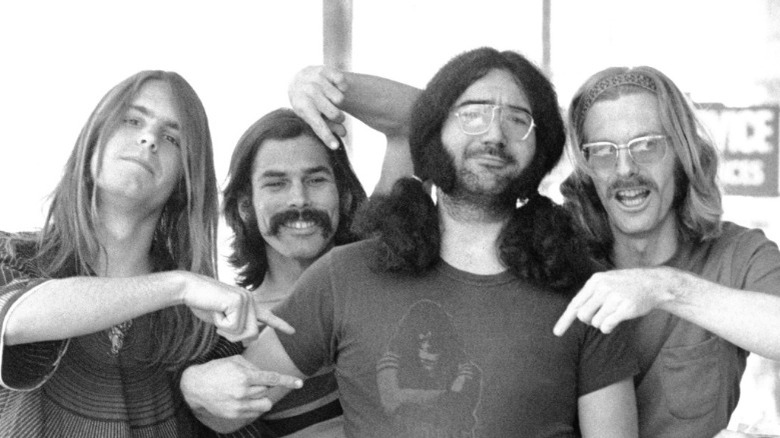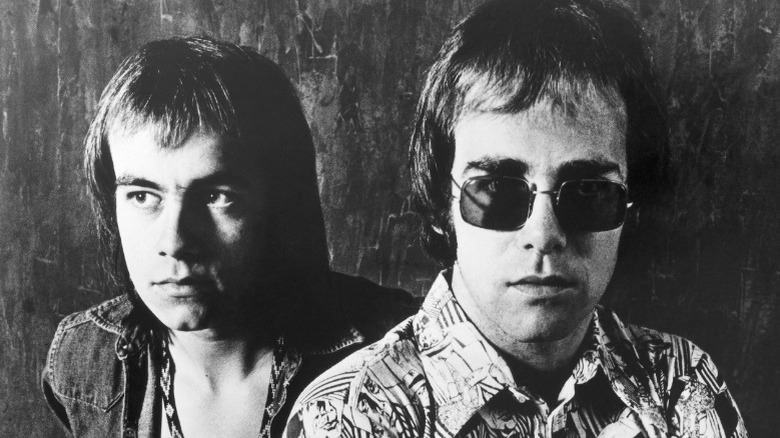Classic Rock Lyrics No One Can Explain
Surprisingly, nothing about rock music is straightforward. In fact, it's hard to even define the genre. According to Britannica, there are many different definitions for rock, most involving blues-influenced electric guitars, strong beats, and loud volume in some way. Classic rock is even harder to quantify. Per LiveAbout, it mainly includes hit rock songs from the '60s, '70s, and '80s that have been around long enough to stand the test of time. As The Guardian notes, classic rock is as much nostalgia for an era as it is a genre. It appears to be linked to the adolescence of Baby Boomers born between 1946 and 1964, meaning most classic rock falls between the years 1964 and 1982.
The term classic rock itself was coined by U.S. radio stations that sought a way to play album-based rock music that was popular but no longer relevant to younger generations. As a result, artists like Elton John and Led Zeppelin ended up in the same genre even though their music is very different. Still, one thing many classic rock artists unite on is zany lyrics, which sometimes become so obscure and over-the-top that even the most diehard fans can't decipher their meaning. From Jimi Hendrix's "Purple Haze" to Heart's "Barracuda" to Def Leppard's "Pour Some Sugar on Me," here are some truly out there classic rock lyrics that no one can explain.
Led Zeppelin – Dancing Days
With its danceable beat and off-kilter melody, 1973's "Dancing Days" has always been considered an outlier in Led Zeppelin's predominantly hard rock catalog. And the song's lyrics are perhaps its wildest feature. Lines like "dancing days are here again, as the summer evenings grow" and "you'll be my only, my one and only" paint a scene of intoxicating summer love (per Genius). But things get a little strange when Robert Plant sings: "You told your mother I'd get you home, but you didn't say that I got no car. I saw a lion, he was standin' alone with a tadpole in a jar." Figuring out how a lack of transportation connects to a lonely lion and a larval frog has left many stupefied over the years.
According to Ultimate Classic Rock, the tune came about when Plant and guitarist Jimmy Page took a trip to Bombay and were enamored with the Indian music they heard there. The experience inspired them to write a song so groovy it caused them to dance, leading to the song's title. Per Ultimate Classic Rock – which awarded the song the number one spot on their list of "Top 10 Most Head-Scratching Led Zeppelin Lyrics" – the lyrics could refer to Plant himself, as his long curly hair resembled a lion's mane. While it's not advisable, taking the metaphor further could mean that the tadpole in a jar is his semen trapped in a condom. But who really knows?
Jimi Hendrix – Purple Haze
Opening with the unforgettable line "purple haze all in my brain," Jimi Hendrix's legendary 1967 hit has kept people guessing for years (per Genius). Outlandish lyrics like "'Scuse me while I kiss the sky" and "You got me blowing, blowing my mind; is it tomorrow, or just the end of time?" pepper the song, punctuated by Hendrix's cries for help. As the jam progresses, he's not sure if he's "happy or in misery," "if it's day or night," or if he's "coming up or down." At one point, he blames his altered state on a girl's spell. But exactly what is going on, and why is everything so hazy and purple?
Over the years, many have speculated that "Purple Haze" was induced by psychedelic drugs. But according to Hendrix (via Far Out Magazine), it was actually inspired by a dream he had after reading a science fiction novel. In the dream, he found himself underwater, surrounded by a thick purple haze which he likened to a spiritual awakening. In fact, the song's original chorus was meant to be "purple haze, Jesus saves." As Hendrix noted (via NPR), his original version was 10 verses long before it was shaved down to 3 minutes. He told reporter Tom Lopez (via Steven Roby's book "Black Gold") that it had about 1,000 words and contained a complete voyage through a mythical land. Who knows, maybe the full version of the song made perfect sense!
America – Ventura Highway
The guitar riff on America's "Ventura Highway" is so catchy even Janet Jackson sampled it in her 2001 song "Someone to Call My Lover." It's the perfect tune for cruising along in the summer with the windows down. But start singing along and you'll quickly realize that the lyrics of the 1972 classic are a recipe for confusion. First, you've got "Ventura Highway" itself, which doesn't exist. Then you have this mysterious Joe character who pops in and out of the song, a reference to "being hit by purple rain" that predates the Prince song by 12 years, and, of course, those "alligator lizards in the air" (per Genius).
As lyricist Dewey Bunnell told American Songwriter, the song's inspiration came from being stopped on the side of the road in California when he was a boy. While his dad fixed the flat tire, young Bunnell took in the sights, which included a freeway sign that read "Ventura" and cloud formations that looked to him like the alligator lizards he and his brother used to catch. For Bunnell – who had lived in both England and the Midwest – California was a magical, eternally sunny place. According to him, Joe represents someone who chose not to move west, citing purple rain as the cause. Bunnell never met Prince – who was 14 years old when "Ventura Highway" was written – but he likes to think the lyric could have inspired him.
The Beatles – I Am the Walrus
The Beatles' 1967 song "I Am the Walrus" off of their Magical Mystery Tour album – an enigma unto itself – will probably go down in history as having the most nonsensical lyrics of all time. Lines like "I am he as you are he as you are me and we are all together," "elementary penguin singing Hare Krishna," "I am the egg man," and, of course, "I am the walrus" have mystified listeners for decades (per Genius). Then there are the cagy characters like Semolina Pilchard and the "crabalocker fishwife" to contend with, not to mention all those "goo goo g'joob"s. Despite years of studious analysis, no one has any clue what the song is about to this day.
According to primary songwriter John Lennon (via American Songwriter), that was precisely the point. When Lennon found out literature classes at his old school were analyzing the meaning of Beatles' lyrics, he set out to write a song so out there that no one could divine its meaning. Once he had crafted the lyrics, he happily told his old friend, Pete Shotton, "Let the f***ers work that one out, Pete!" Later, Lennon told Playboy (via American Songwriter) that the lyrics were inspired by several acid trips as well as by the Lewis Carroll poem "The Walrus and the Carpenter" from Carroll's book "Through the Looking-Glass." And that's about as much of an explanation as we'll ever get.
Dio – Holy Diver
Dio's epic 1983 song "Holy Diver" certainly tells a story; the only problem is you're never quite sure exactly what's going on. First, you've got the titular Holy Diver, who has been "down too long in the midnight sea" (per Genius). Then, you're riding the tiger and "you can see his stripes, but you know he's clean." Amidst pearls of wisdom like "life's a never-ending wheel" and "some light can never be seen," you have a ton of cat-related imagery. And at one point, singer Ronnie James Dio emphatically asks, "Oh, don't you see what I mean?" No, not quite.
As lyricist Ronnie James Dio told Banger in 2004 (via Rocking in the Norselands), it's a religious song about a Christ-like figure on another planet – the Holy Diver – who must travel to other worlds to save more lives. As Dio noted, "The tiger symbolizes strength, while its stripes suggest impurity." Riding the tiger, therefore, meant harnessing its strength without judging its imperfections. He claimed it was a song about the selfishness of humanity, who wanted to keep the Holy Diver to themselves rather than allow him to venture forth and save more people. While Dio's metaphors are sound, the lyrics of this powerful and imaginative song ultimately make sense to him and no one else.
The Grateful Dead – China Cat Sunflower
The title of this 1969 Grateful Dead classic alone induces head scratching. And it doesn't get any clearer as the lyrics progress to include "Copperdome Bodhi drip a silver kimono, like a crazy quilt stargown through a dream night wind," "Krazy Kat peeking through a lace bandanna," and "comic book colors on a violin river crying Leonardo words from out a silk trombone" (per Genius). Let's be honest, The Dead are well-known for dabbling in the psychedelic realms. But they have also given us some of the most genius and astute lyrics over the years, including such tattoo-worthy lines as, "Every silver lining has a touch of grey."
As the band's lyricist Robert Hunter told Fresh Air (via NPR), the lyrics of "China Cat Sunflower" are, in his own words, "Joycean word salad." Nonetheless, he went on to say, "Some people, strangely enough, know just what I mean by it. But don't – I couldn't explain that." As Hunter told Robert Gans (via Dead.net), the inspiration for the song came when he was in a "hypersensitive state" in Mexico with a cat sitting on his stomach. He claims that the cat then led him to Neptune, where he beheld many cats marching across a rainbow. It's not clear if anyone can truly understand what Hunter saw that day, but "China Cat Sunflower" is his attempt at sharing it with the world.
Steve Miller Band – The Joker
For the most part, Steve Miller Band's 1973 classic "The Joker" is a straightforward little ditty. Miller's a joker – a gregarious light-hearted guy who just wants to play his music in the sun (per Genius). But some of his lyrics raise a few questions. For one, what is a "space cowboy" and why is it juxtaposed with "the gangster of love?" Who is Maurice, and why does he "speak of the pompatus of love?" And while we're on the subject, exactly what is a "pompatus of love?"
While "space cowboy," "the gangster of love," and even Maurice are nods to Steve Miller's earlier works and can therefore be explained (per The Straight Dope), such is not the case for "the pompatus" – a word Miller completely made up. It's possible he was inspired by The Medallions' 1954 R&B song "The Letter," in which vocalist Vernon Green sang of a "puppetutes" – a word he himself had invented to describe a paper doll fantasy woman. In an interview with AXS TV, Miller claimed the "pompatus" is "whatever you want it to be." He even cites Paul McCartney, who once told him to write whatever lyrics worked, as an influence in its creation.
Queen – Bohemian Rhapsody
While you probably know every word by heart, lyrically, it really doesn't get much weirder than Queen's 6-minute 1975 rock opera "Bohemian Rhapsody." Between howling guitar solos and tender piano moments, you've got a murder confession, a deathbed farewell, and an endless list of seemingly unconnected historical references, including the Scaramouche (comic servants in classic Italian theater, per Britannica), Galileo (the Italian astronomer), the Fandango (a fast Spanish dance), Figaro (the comic barber in various plays), Bismillah (an Arabic phrase meaning "in the name of Allah," per Dictionary.com), and Beelzebub (the prince of devils in The Bible, per Genius).
As American Songwriter notes, frontman Freddie Mercury never really explained the song's meaning. But, according to many people close to him, it was likely a poetic take on Mercury coming out as bisexual. As his longtime partner Jim Hutton told Mercury's biographer Lesley-Ann Jones (via Genius), the song served as his confessional: "It was about how different his life could have been, and how much happier he might have been, had he just been able to be himself the whole of his life." Lyricist Tim Rice, who worked with Mercury, told The New Zealand Herald (via Genius) that the song's murder refers to Mercury killing the straight version of himself, and the rest of the song is him reconciling the new version with the old. Sadly, we'll never know the truth.
Elton John – Solar Prestige a Gammon
Elton John's jaunty but bizarre 1974 song "Solar Prestige a Gammon" may have come as a surprise to his fans. In addition to its gobbledygook title, it features lyrics like "kool kar kyrie kay salmon," "oh ma cameo molesting," and "common lap kitch sardin a poor floundin" (per Genius) – strange words from the man who brought us eloquently straightforward classics like "Your Song" and "Rocket Man (I Think It's Going to Be a Long, Long Time)."
According to John in his biography, "His Song" by Elizabeth Rosenthal, the song's lyrics were meant to sound great without meaning a thing. Inspired by The Beatles' song "Sun King," in which made-up Italian-sounding words flow beautifully with the music, John asked his lyricist Bernie Taupin to intentionally compose nonsense which he then sang with operatic gusto. As John noted, "This is one of my bright ideas that Bernie is going to get crucified for."
Heart – Barracuda
The anger in Heart's 1977 classic "Barracuda" is evident, but the sea life swimming through its lyrics becomes distracting. Lines like "You lying so low in the weeds, I bet you're gonna ambush me. You'd have me down, down, down, down on my knees, now wouldn't you, Barracuda?" and "'Sell me, sell you,' the porpoise said" seem vaguely metaphorical, but their meanings are not clear (per Genius). Exactly what do predatory fish and talking porpoises have to do with anything?
According to Far Out Magazine, Heart's Ann Wilson wrote the words to "Barracuda" in a hotel room immediately after an encounter with a sleazy promoter who assumed she was dating her sister, Nancy Wilson. Its creation was fueled by anger at the music industry's rampant sexism. As the band's producer Mike Flicker told Mix Magazine (via Far Out Magazine), "'Barracuda' could be anyone from the local promotion man to the president of a record company." As for the porpoise, Ann told Rolling Stone it was a nickname she and her sister shared at the time, inspired by none other than The Beatles' song "I Am the Walrus."
Bruce Springsteen/Manfred Mann's Earth Band – Blinded by the Light
Here you have two versions of the same song, each confounding in its own way. Known for his verbose lyrics, Bruce Springsteen originally wrote "Blinded by the Light" in 1973, filling it with perplexing lines like "Madman drummers bummers and Indians in the summer with a teenage diplomat" and "Some brimstone baritone anti-cyclone rolling stone preacher from the East, he says, 'Dethrone the Dictaphone, hit it in its funny bone, that's where they expect it least" (per Genius). While the words are mystifying, Springsteen told VH1 Storytellers (via Ultimate Classic Rock), "I was 23 years old, I wanted to create my own ridiculous language. So, it was really a young musician's tale, a litany of adventures and rather on the autobiographical side."
Manfred Mann's Earth Band covered the song in 1976, and their version is now the most well-known. As American Songwriter notes, they turned the already 5-minute song into a 7-minute epic, spicing things up with fast guitar solos and a lively albeit completely random rendition of "Chopsticks." They also changed Springsteen's line "cut loose like a Deuce" to "revved up like a Deuce" – but somehow, everyone hears it as "wrapped up like a douche." Thus, a lyric about a hot rod car that once made sense was rendered absurd by a musical game of telephone.
Def Leppard – Pour Some Sugar on Me
Def Leppard's 1987 rocker "Pour Some Sugar on Me" is clearly about sex, but exactly how it's all happening is a little puzzling. Lines like "livin' like a lover with a radar phone," "razzle n' a dazzle n' a flash a little light," and "television lover, baby, go all night" baffle, to say nothing of the chorus: "Pour some sugar on me, ooh in the name of love" (per Genius). Is pouring sugar on your lover a real thing?
According to frontman Joe Elliot (via Songfacts), the song is "the metaphor for whatever sexual preference you enjoy." Elliot claims the lyrics were loosely inspired by The Archies' 1969 song "Sugar, Sugar" as well as the lewd but nonsensical imagery of T. Rex's "Bang a Gong (Get it On)." When writing the lyrics, he started with phonetic sounds that fit the music rather than words, which could explain why the song is full of sugary visuals but doesn't make a lick of sense.
Warren Zevon – Werewolves of London
In the opening verse of Warren Zevon's wacky 1978 piano ditty "Werewolves of London," a werewolf searches the rainy streets of Soho for "a big dish of beef chow mein" (per Genius). Elsewhere in the song, werewolves are mentioned doing more werewolfy things like howling around doors, mutilating little old ladies, and potentially ripping Jim's lungs out. But in the fourth verse, Zevon sings, "I saw a werewolf drinking a piña colada at Trader Vic's and his hair was perfect." What's going on with these uptown London lycanthropes?
According to American Songwriter, it all started when Phil Everly of The Everly Brothers told Zevon about the 1935 film "Werewolf of London." Zevon enjoyed the idea of a dapper London werewolf – a murderous monster that was also trendy and had clout with celebrities like the queen. Guitarist Waddy Wachtel developed the song's main riff and first verse, Zevon added the piano and more outlandish lyrics, and Zevon's wife Crystal jotted down everything they came up with. When it was released, Zevon was afraid it would be viewed as a novelty song. And while that's partially true, it's also a timeless classic – even if listeners don't understand it at all.

